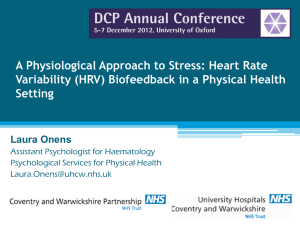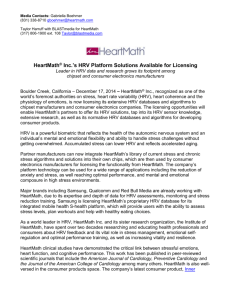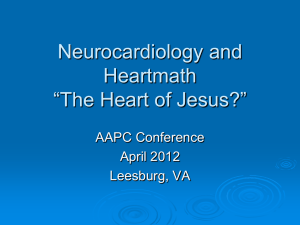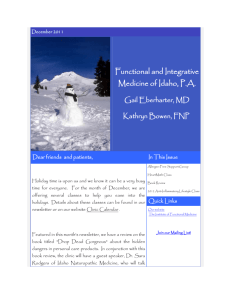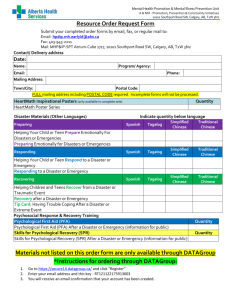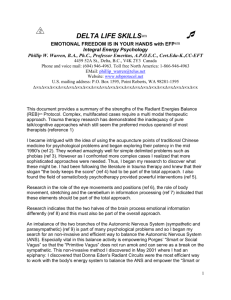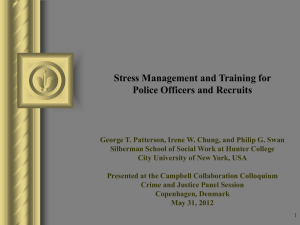HeartMath – Current Projects
advertisement
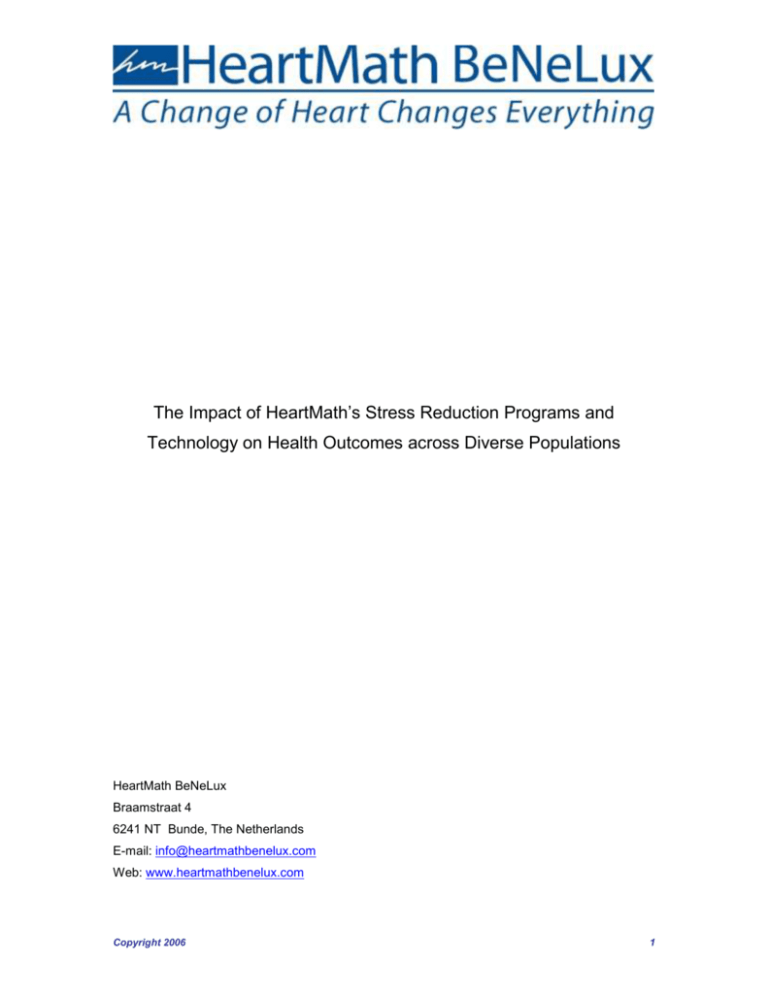
The Impact of HeartMath’s Stress Reduction Programs and Technology on Health Outcomes across Diverse Populations HeartMath BeNeLux Braamstraat 4 6241 NT Bunde, The Netherlands E-mail: info@heartmathbenelux.com Web: www.heartmathbenelux.com Copyright 2006 1 Executive Summary The HeartMath system of stress reduction techniques and heart rhythm monitoring technology has been tested in multiple settings around the world since 1992. Unlike other approaches to stress reduction, HeartMath's scientifically validated programs build on breakthrough research into the critical heart-brain communication system, teaching users how to optimize the very physiological processes that underpin health, well-being and high performance, or undermine them. This document highlights key health outcomes on patient as well as workplace populations. Blood Pressure Reduction: the treatment group exhibited a mean adjusted reduction of 10.6 mm Hg in systolic BP and of 6.3 mm Hg in diastolic BP. The treatment group also demonstrated improvements in emotional health, stress symptoms, depression, and global psychological distress, and saw significant increases in peacefulness and positive outlook. Congestive Heart Failure: Significant improvements (p<0.05) were noted in perceived stress, emotional distress, 6-minute walk (14% improvement in functional capacity), and depression, and positive trends were noted in each of the other psychosocial measures. Diabetes: Participants experienced significant reductions in psychological symptomatology and negative emotions, including anxiety, depression, anger and distress, following the intervention. Significant increases in peacefulness, social support and vitality were also measured, as well as reductions in somatization, sleeplessness and fatigue. Participants showed reduced sensitivity to daily life stressors, and quality of life significantly improved. Regression analysis revealed a significant relationship between self-reported practice of the techniques learned in the program and the change in HbA1c levels in patients with Type 2 diabetes. Practice of the HeartMath techniques resulted in 1% reduction in HbA1c. Stress and Workplace Well-Being: A study at a global manufacturing company showed that contentment, job satisfaction and communication significantly increased, while tension, anxiety, nervousness and physical symptoms of stress significantly decreased. Blood pressure in hypertensive individuals decreased, and there was reduction in sympathetic nervous activity. Quality improvements – reduction in defects -- were noted among factory workers. Stress and Health Risk Reduction in Correctional Officers: Employees in the experimental group demonstrated significant reductions in stress and health risk factors, as well as significant improvements in work-related parameters. Physiological changes in the experimental group included significant reductions in total cholesterol, LDL cholesterol levels, the total cholesterol/HDL ratio, fasting glucose levels, mean heart rate, and systolic and diastolic blood pressure. Psychological changes included significant reductions in overall psychological distress, anger, fatigue, hostility, interpersonal sensitivity, speed and impatience, and global Type A behavior, and increases in gratitude and positive outlook. There were also improvements in key organizationally relevant measures, including significant increases in productivity, motivation, goal clarity, and perceived manager support. The reduction in health risk factors achieved in this study are projected to lead to reductions in both health care and absentee costs, yielding a total projected annual cost savings of $699 per employee. 3/8/2016 2 3/8/2016 3 Research Summaries Impact of a Workplace Stress Reduction Program on Blood Pressure and Emotional Health in Hypertensive Employees Rollin McCraty, Ph.D., Mike Atkinson, and Dana Tomasino, B.A. Journal of Alternative and Complementary Medicine. 2003; 9(3): 355-369. Abstract Objectives: This study examined the impact of a workplace-based stress management program (HeartMath) on blood pressure (BP), emotional health, and workplace-related measures in hypertensive employees of a global information technology company. Design: Thirty-eight (38) employees with hypertension were randomly assigned to a treatment group that received the stress-reduction intervention or a waiting control group that received no intervention during the study period. The treatment group participated in a 16-hour program, which included instruction in positive emotion refocusing and emotional restructuring techniques intended to reduce sympathetic nervous system arousal, stress, and negative affect, increase positive affect, and improve performance. Learning and practice of the techniques was enhanced by heart rate variability feedback, which helped participants learn to self-generate physiological coherence, a beneficial physiologic mode associated with increased heart rhythm coherence, physiologic entrainment, parasympathetic activity, and vascular resonance. BP, emotional health, and workplace-related measures were assessed before and 3 months after the program. Results: Three months post-intervention, the treatment group exhibited a mean adjusted reduction of 10.6 mm Hg in systolic BP and of 6.3 mm Hg in diastolic BP. The treatment group also demonstrated improvements in emotional health, including significant reductions in stress symptoms, depression, and global psychological distress and significant increases in peacefulness and positive outlook. Furthermore, the trained employees demonstrated significant increases in the work-related scales of workplace satisfaction and value of contribution. A Controlled Pilot Study of Stress Management Training of Elderly Patients with Congestive Heart Failure Frederic Luskin, PhD, Megan Reitz, BA, Kathryn Newell, MA, Thomas Gregory Quinn, MD, William Haskell, PhD Preventive Cardiology 2002;5(4):168-172, 176. Abstract The purpose of this study was to evaluate the effect of stress management training on quality of life, functional capacity, and heart rate variability in elderly patients with New York Heart Association class I-III congestive heart failure (CHF). While substantial research exists on stress management training for patients with coronary heart disease, there are few data on the value of psychosocial training on patients with CHF. Thirty-three multiethnic patients (mean age, 66±9 years) were assigned through incomplete randomization to one of two treatment groups or a waitlisted control group. The 14 participants who completed the treatment attended eight training sessions during a 10-week period. The training consisted of 75-minute sessions adapted from the Freeze-Frame stress management program developed by the Institute of HeartMath. Subjects were assessed at baseline and again at the completion of the training. Depression, stress management, optimism, anxiety, emotional distress, and functional capacity were evaluated, as well as heart rate variability. Significant improvements (p<0.05) were noted in perceived stress, emotional distress, 6minute walk, and depression, and positive trends were noted in each of the other psychosocial measures. The 24-hour heart rate variability showed no significant changes in autonomic tone. The authors noted that CHF patients were willing study participants and their emotional coping and functional capacity were enhanced. This program offers a simple and cost-effective way to augment medical management of CHF. Given the incompleteness of CHF medical management and the exploding interest in complementary medical intervention, it seems imperative that further work in psychosocial treatment be undertaken. 3/8/2016 4 Emotional Self-Regulation Program Enhances Psychological Health and Quality of Life in Patients with Diabetes Rollin McCraty, Ph.D., Mike Atkinson, and Lee Lipsenthal, M.D. HeartMath Research Center, Institute of HeartMath, Publication No. 00-006. Boulder Creek, CA, 2000. Summary Aims: This pilot study was designed to assess changes in psychological status, quality of life and hematologic measures predictive of long-term health and well-being in patients with diabetes following a stress reduction and emotional self-regulation program. Methods: Twenty-two patients with Type 1 or Type 2 diabetes mellitus participated in a 2-day HeartMath workshop, a research-based program developed to reduce stress and negative affect, increase positive affect and reduce inappropriate autonomic nervous system activation. Self-report measures of stress, psychological status and quality of life were administered before and six months following the intervention. Hemoglobin A1c, cholesterol and triglycerides, and blood pressure were also assessed. Results: Participants experienced significant reductions in psychological symptomatology and negative emotions, including anxiety, depression, anger and distress, following the intervention. Significant increases in peacefulness, social support and vitality were also measured, as well as reductions in somatization, sleeplessness and fatigue. Participants showed reduced sensitivity to daily life stressors after the intervention, and quality of life significantly improved. Regression analysis revealed a significant relationship between self-reported practice of the techniques learned in the program and the change in HbA1c levels in patients with Type 2 diabetes. Increased practice was associated with reductions in HbA1c. Conclusions: Results suggest that the HeartMath emotional self-regulation intervention reduces stress, improves psychological health, enhances quality of life and may improve glycemic control in individuals with diabetes. Replication of this study with a non-treatment control group is necessary to confirm these findings. An Inner Quality Approach to Reducing Stress and Improving Physical and Emotional Wellbeing at Work Bob Barrios-Choplin, Ph.D., Rollin McCraty, Ph.D., and Bruce Cryer, M.A. Stress Medicine 1997: 13(3): 193-201. Summary This exploratory field study examined the impact of an Inner Quality Management program (IQM) on three groups of Motorola employees. IQM is a training program designed by HeartMath to help people increase productivity through improved health, communication, goal clarity, positive mood and job satisfaction, and through the reduction of tension, burnout, physical symptoms of stress and negative mood. Both psychological and physiological measures were assessed in the 6-month study. The study involved three groups: managers, engineers and factory workers. Results showed that contentment, job satisfaction and communication significantly increased after the training, while sleeplessness, tension, anxiety, nervousness and physical symptoms of stress significantly decreased. Blood pressure in hypertensive individuals decreased, and there was reduction in sympathetic nervous activity. Implications for workplace wellbeing are discussed. 3/8/2016 5 Impact of the Power to Change Performance Program on Stress and Health Risks in Correctional Officers Rollin McCraty, Ph.D.*, Mike Atkinson*, Lee Lipsenthal, M.D.*, and Lourdes Arguelles, Ph.D.** *HeartMath Research Center, Institute of HeartMath, Boulder Creek, CA **Claremont Graduate University, Claremont, CA HeartMath Research Center, Institute of HeartMath, Report No. 03-014. Boulder Creek, CA, November 2003. Summary This study investigated the impact of HeartMath’s Power to Change Performance stress and health risk reduction program on physiological and psychological stress and health risk factors in a sample of correctional peace officers. Eighty-eight officers from three facilities were randomized to an experimental group and a wait-list control group. The experimental group participated in the stress and health risk reduction program, which was delivered over two consecutive days. The program included instruction on health risk factors as well as training in positive emotion-focused stress reduction techniques intended to reduce negative emotional arousal, improve physiological balance, increase positive affect, and enhance performance. Learning and practice of the techniques was enhanced by heart rate variability feedback, which helped participants learn to selfgenerate physiological coherence, a beneficial mode associated with increased efficiency and synchronization in the functioning of physiological systems. Measures of physiological and psychological stress and health risk were assessed before the program and again 3 months afterward. The measures included in the health risk assessment were the Personal Wellness Profile self-report survey, which assesses a broad range of health-related information, behaviors, and attitudes; and four biometric markers: height, weight, blood pressure, and total cholesterol levels. Additional measures reflective of physiological stress and overall health included cortisol and DHEA, secretory immunoglobulin A (an immune system marker), HDL and LDL cholesterol, triglycerides, fasting glucose levels, a 10-minute resting electrocardiogram, and measures of heart rate variability (an indicator of autonomic function). Three self-report psychological surveys were also included to assess emotional stress and work-related variables. An analysis of baseline data revealed that officers in this study were under greater stress and at greater health risk in comparison to a reference sample of working adults. A within-group analysis of pre-post changes showed that 3 months after the intervention program, employees in the experimental group demonstrated significant reductions in stress and health risk factors, as well as significant improvements in work-related parameters. Physiological changes in the experimental group included significant reductions in total cholesterol, LDL cholesterol levels, the total cholesterol/HDL ratio, fasting glucose levels, mean heart rate, and systolic and diastolic blood pressure. Psychological changes included significant reductions in overall psychological distress, anger, fatigue, hostility, interpersonal sensitivity, speed and impatience, and global Type A behavior, and increases in gratitude and positive outlook. There were also improvements in key organizationally relevant measures in the experimental group after the program, including significant increases in productivity, motivation, goal clarity, and perceived manager support. Finally, the reduction in health risk factors achieved in this study are projected to lead to reductions in both health care and absentee costs, yielding a total projected annual cost savings of $699 per employee. In conclusion, the results of this study indicate that the Power to Change Performance program was effective in significantly reducing stress and health risk factors in a population of correctional peace officers, while enhancing employee productivity and psychological well-being. These changes were realized with minimal intervention and in a relatively brief period of time, and should result in significant cost savings to the organization if the program is expanded to larger employee populations. Thus, by reducing the physiological, psychological, performance-related, and financial impact of high stress and health risks in the crucial and demanding profession of corrections work, this program promises significant benefits both to the employees as individuals and to the organization as a whole. 3/8/2016 6 Key HeartMath Projects GLOBAL BUSINESS BP HeartMath has worked with BP on four continents since 1998, training more than 3,000 BP leaders, managers, and line staff. BP has identified $1bn in annual costs globally due to the impact of stress on absenteeism, health care costs, etc. In Q1’06, BP is launching a major Global Health initiative to address the problem. HeartMath is being offered as the only global solution for stress. HeartMath is being rolled out to 3,000 employees in BP Houston as part of their health initiatives. A safety study utilizing HeartMath technology is ongoing at a BP Chemicals plant in England. Unilever HeartMath productivity and performance tools – including the Freeze-Framer -- are also being rolled out to nearly 2,000 corporate staff in London and Rotterdam as part of the following initiatives: the One Unilever campaign to facilitate the merger between the two halves of Unilever’s business (food and home & personal care products) Vitality, which is Unilever’s new re-branding effort, to revitalize the culture of Unilever and develop the “whole person.” Shell: Shell has identified stress as the number one employee risk. Based on data collected on the HeartMath program’s effectiveness at Shell since 1997, the HeartMath program is now being rolled out to employees of ExPro (Exploration & Production). Previous research on 8 Shell oil platforms in the North Sea showed improvements in safety as a result of the HeartMath program. Motorola Motorola piloted HeartMath’s Power to Change Performance program with: o Executives and administrative staff at corporate headquarters o Software engineering team o Manufacturing team in a factory Data highlights: o 22% reduction in defects at the factory o Doubling of patentable ideas by software team o All executives in the program lowered blood pressure to normal levels o HeartMath project won the Creativity and Innovation Award from Motorola as part of their Total Customer Satisfaction competition. Harvard Business Review o HeartMath’s research on executive health and stress reduction was featured in the July 2003 issue, entitled “Pull the Plug on Stress.” 3/8/2016 7 HEALTH CARE Duke University Hospital A pilot program with 350 staff in Duke’s Emergency Services division begins Q1 ’06. HeartMath’s Freeze-Framer technology is being used in Duke’s Diet and Fitness program. Stanford Hospital and Clinics HeartMath’s Power to Change Performance program is being offered to clinical staff as part of Stanford Hospital’s public professional education and development series. A pilot study conducted through Stanford School of Medicine on congestive heart failure included HeartMath training (see Research Summaries above) Center for the Health Professions (at UCSF) HeartMath’s Power to Change Performance program is part of the Center’s curriculum for: o Kaiser Pharmacy Leaders o California Health Care Fellows Program The Freeze-Framer technology is being used at UCSF’s Integrative Medicine Center Kaiser Permanente HeartMath programs and technology are being used throughout the Kaiser system: o Pain management clinics o Leadership training for pharmacy leaders o Call center training to reduce absenteeism o Nurse retention and nurse leadership Delnor-Community Hospital (Chicago, IL): Delnor has successfully reduced employee turnover from 27 to 14% in the four years since they began working with HeartMath. o The turnover rate for HeartMath-trained staff has not exceeded 6%. o The hospital is saving approximately $800,000 per year from the retention improvements. Delnor has been ranked #1 nationally in employee satisfaction two out of the past three years, according to a survey of community hospitals. Delnor has seen customer (patient) satisfaction grow from 73% to 98%. Delnor won the 2002 Corporate Health and Productivity Management Award (along with Lockheed Martin and Pitney Bowes) Delnor and HeartMath won the 2005 Management Innovations Award from the American College of Healthcare Executives. Swedish Medical Center (part of HCA) Reported staff turnover improvements from 22% to 9% for the first 600 staff trained in the HeartMath program. Jobs saved = 78. Sierra Providence Health Network (part of Tenet) • In the first year, for HeartMath-trained staff: • Reduced nurse turnover from 21% to 3% in the first year. • Reduced overall staff turnover from 21% to 5% in the first year. • Based on Staff Turnover cost of $48,000, the network saved: • 19 nursing jobs = $912,000 • 45 overall jobs = $2,160,000 3/8/2016 8 GlaxoSmithKline: HeartMath Power to Change Performance program is being piloted through multiple workshops in the UK, in advance of embedding in their global Resilience program. Sales teams around the US have participated in the HeartMath program. Blue Cross Blue Shield of Tennessee (BCBST) BCBST has piloted HeartMath’s program to improve employee performance and productivity, while reducing stress. The program is now being rolled out to 1,000 call center agents and nursing staff, as part of their corporate wellness initiative. HeartMath has health care system clients in New York, California, Texas, Indiana, Illinois, Florida, Minnesota, North Carolina, Tennessee, Oregon, and Hawaii. EXECUTIVE EDUCATION Stanford University Graduate School of Business HeartMath content has been part of the Stanford Executive Program since 1997. o Program focuses on helping the 100+ senior executives from all over the world transition back to their country, company and family after six weeks of intense business and professional development at Stanford. In 2005, HeartMath program introduced additional module on how to maximize learning while at Stanford. Columbia Business School HeartMath’s Power to Change Performance program – and Freeze-Framer technology -- is being imbedded in the Columbia Senior Executive Program. Program attracts 50+ senior executives from all over the world to learn how to transform their leadership skills and personal mastery. London Business School HeartMath’s Power to Change Performance program – and Freeze-Framer technology -- are being imbedded in various MBA and executive education programs at London Business School. International Center for Leadership in Finance (Kuala Lumpur) HeartMath’s Power to Change Performance program is a core component of a four week leadership program for senior executives of Malaysian, Singaporean and Asian companies, delivered twice a year in the US since 2004. Global Institute for Leadership Development (GILD) The HeartMath program is embedded in the leadership curriculum of this global conference, put on by Linkage. Program will be offered in Palm Springs and Singapore in 2006. GOVERNMENT CLIENTS NASA – Goddard Space Flight Center Office of Personnel Management US Department of Education All four branches of US Military 3/8/2016 9
